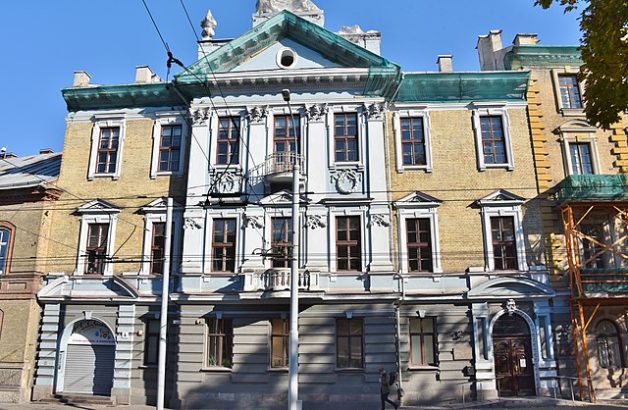Opened in 2024, the Museum of Culture and Identity of Lithuanian Jews is the largest branch of the Vilna Gaon Museum of Jewish History. Adam J. Sacks suggests the ‘Litvak’ museum is an outstanding professional achievement but questions its failure to face the full truth of Lithuania’s wartime past and its tendency to ‘push too many shiny round Jewish pegs into modern-day ethnonationalist square holes’.
Gershom Scholem famously denounced the idea of a so-called ‘German Jewish symbiosis,’ claiming that it was really a one-sided dialogue of Jews amongst themselves. Further, he claimed that there was something historically perverse in anointing Jews as Germans only after they had been banished and killed. A parallel fate has befallen the cognitive cousins of the Yekkes, namely the Litvaks, similarly renowned for their intellectuality, albeit of a decidedly more Jewishly Jewish stripe. As fellow overachievers, and masters of sublimation, Litvaks also leave behind a galaxy of stars, only now celebrated and claimed in a homeland from whence they were not only killed, but almost completely annihilated, and largely at the hands of ‘fellow’ Lithuanians. Whilst German Jewry, with a lot more advanced warning, managed to help 60 per cent of their community escape, including almost all of their younger generation, Lithuania was the site of the hard core of the Holocaust, maybe even the hardest core of any genocide ever recorded. Lithuania had the highest rate of Jewish death anywhere in Europe, about 96 per cent. Before diving into anything about contemporary Lithuania and Jewish issues, perhaps the following should first be taken under advisement as a ‘historian’s general warning’:
- Lithuania provided the highest amount and highest proportional quantity of non-German ‘willing executioners’ of any European country.
- In dozens of Lithuanian towns, all of the Jews were murdered in the near-absence of any (Austro)-Germans whatsoever.
- Nazi authorities brought Jews from other countries, notably, Central Europe, to Lithuania to be killed.
- The LAF (Lithuanian Activist Front) leaflets in the lead-up to the Nazi invasion of 22 June 1941 called for the elimination of all Jews from Lithuania. One circular promised amnesty to criminals who could prove they had killed a Jew.
- In the days after the Nazi invasion of 22 June 1941, the LAF set up roadblocks around many towns to prevent Jewish flight to the East.
- The ‘Provisional Government’ set up on 23 June 1941 approved the arrest, deportation to mass murder sites, and the order for ghettoization of much of Lithuanian Jewry.
- Lithuania is home to the city on earth, Kaunas, with the more monuments than any city on the planet to genocidal killers and Nazi collaborators (counting street names, plaques, museum exhibits, displays, and more).
- An excerpt from a text released by the ‘Lithuanian Activist Front’ at the time of the Nazi invasion: ‘The Jews are to be expelled completely and for all time. If any one of them should dare to believe that in the new Lithuania he will nevertheless find a refuge of sorts, let him learn today the irrevocable judgment on the Jews: in the newly restored Lithuania not even one Jew will have either the rights of citizenship or the means of earning a living. In this way, we will rectify past mistakes and repay Jewish villainy. In this way, we will lay a strong foundation for the happy future and creative work of our Aryan nation.’
Given all this, it is bewildering to confront on the streets of contemporary Vilnius, a myriad of Jewish representations of such density with hardly any parallel in any other European city. Beyond standard historical plaques or tablets, there are three different buildings dedicated to Jewish museums and even a number of life-size stone sculptural representations on the sidewalks, supposedly of Jews, in several places in the Old City. Most conspicuous amongst these is the supersized bust of the Vilna Gaon, Elijah ben Solomon Zalman, himself, erected on the grounds of the vaunted complex of the Shulkloyz. Leaving aside the fact that the depiction resembles a cross between the Golem and a marvel monster, this stone edifice whimpers ‘I am not kosher’ from every pore. Such manifestations, as well as comic books dedicated to certain Jewish topics, veer not only towards the unseemly but the outright sacrilegious, as Jewish custom explicitly forbids such figuration. The impression one receives is that Lithuania’s’ Jewish heritage is being instrumentalised in an almost overwhelming manner for international (read: tourist) consumption, staving off queries about Jewish absence before they can even be formulated.
One of these museums is worth a closer look, especially considering it is newly opened with a brand new exhibit. This ‘Litvak Museum,’ claims it is the first museum in the country to present Lithuania’s Jewish History in a ‘comprehensive’ way. The term Litvak is introduced on posters and walls, throughout the city and the exhibit, bandied about as if a magic talisman. It is worth taking a moment to interrogate this usage widespread in Lithuania, as numerous other projects invoke this term or even employ it in their project title. This very pervasiveness is itself confounding. Very much akin to the term Yekke mentioned at the outset, for most of its history, it has been a term used almost exclusively by and amongst Jews. Granted that Yekke is of a much more recent vintage, yet I know of no single institution or project in Germany that adopts this term in any serious or primary manner.
In contemporary Lithuania, Litvak has generally over taken the use of the phrase Lithuanian Jewish, one wonders whether it is precisely for that reason: Litvak already suggests within itself the word ‘Jewish’ without having to pronounce that possibly discomfiting term. (Apparently the current head of the state-aligned official Lithuanian Jewish community, a contested and fraught figure, has even renamed the official community with the term Litvak, to align with its broader usage.) This term has clearly been appropriated to constitute a pillar of post-Soviet Lithuanian patriotism.
It is vital to clarify that the persistence of the term Litvak amongst Jews aligns barely if at all with the current state sponsored usage in Lithuania. First of all in Jewish circles, this term today survives mostly among Orthodox or ultra-Orthodox. Most Reform or secular Jews in America, even those of Litvak heritage are more than likely to have never heard of the term. Any widespread currency or usage of the term largely died out in the immediate post-immigrant generation, incidentally, a similar fate, also befell the term Yekke. The term more commonly encountered is litvish the adjective form rather than Litvak as a proper noun. Additionally, litvish is almost entirely coterminous with a specific sub-denomination of ultra-Orthodox Judaism, namely the Misnagdim or the opponents of Hasdim. To the untrained eye, it is easy to confuse the two groups, as they adhere to roughly similar dress codes. Yet in their religious world view they are almost opposites. Litvish Judaism eschews the rambunctious joy and popular mysticism of the various Hasidic sects all centred around the charisma of their various Rebbes. Litvish practice is all about advanced Talmudic study and rationalistic scrupulous observance, their sine qua non is the Yeshiva: the equivalent of tertiary level ‘colleges’ that include entrance exams, final ‘orals,’ as well as electives and a multi-part curriculum varied within the bounds of Talmudic learning. Arguably, this system of learning as well as the actual institutions themselves have the widest and most vibrant reach of any aspect of Litvak heritage.
To further complicate matters, students at these Yeshivas, each of which today can number up to 3,000 enrolees, are by no means of actual Litvak extraction. That is to say that more likely than not, they do not have any familial or ancestral lineage that links them to the ethnic or linguistic implications of the term Litvak. So, what exactly does the contemporary Lithuanian widespread use of the term Litvak mean. Well, it corresponds to the boundaries of a pre-modern state, the Grand Duchy of Lithuania, which enjoyed, a brief period of independence, over 500 years ago, until a union with the Polish Kingdom in 1516. The territory of this state included, in addition to most of modern-day Lithuania, all of today’s Belarus, more than half of today’s Latvia, an eastern strip of Poland and a northern strip of contemporary Ukraine. A multinational and multicultural state, the elite of Lithuanian nobility were more likely to have spoken Polish rather than Lithuania and state documents were produced largely either in Latin or Belarusian. The Jews within these boundaries did develop a unique dialect of Yiddish and a distinct geographic identity, but it must be emphasised that the vast majority of these Jews did not have Lithuanians for neighbours nor were they in any sense culturally or linguistically Lithuanian.
If anything, what propelled Litvak Jews to such intensive Judaic heights of achievement was that they largely operated in a kind of cultural vacuum, a singular borderland. The cultural overlords of Russifiers and Polonisers, or even the Baltic German descendants of the Teutonic Knights were for a long while at a safe distance. The core Lithuanian population was small and possessed of an enigmatic ancient Indo-European language. In short, what made Litvaks Litvaks was precisely their non-Lithuanianness. Lithuania was one of the few areas of Europe where no cultural symbiosis emerged between Jews and their neighbours, especially unlike that in Germany, Poland, Russia or even Hungary. In short, the Litvak space was one of a cultivation of a deep Judaic interiority, quasi-Buddhistic, befitting the easternmost settlement of Ashkenaz.
None of this stops this new museum from claiming far and wide Jews that have rather tenuous links to things Lithuanian as their own. Specifically, the city of Vilna, when it was arguably at its height as a seat of Jewish achievement, from around 1850-1941, years that saw the foundation of the Bund, the Strashun Library, the YIVO scientific institute or the modernist Vilna Truppe art theatre group, was a either a city of the Russian Empire or of the Second Polish Republic after World War One, with an actual Lithuanian population of 2 per cent and then 6 per cent, respectively. It is interesting to note that during that same period in Independent Lithuania, the interwar period where the ‘temporary capitol’ was Kaunas, Jewish cultural output was largely characterised by a distinct Zionist orientation with innovative cultural and educational work accomplished mostly in the Hebrew language.
This new museum seems single-minded if not obsessive about naming, cataloguing, even collecting famous Jews, as if the brighter the stars the more they blind out the darkness; it is an obsessive search for cultural capital, translating names into value. Such panegyrics to exceptional Jewish achievements, as Adorno once wrote, gives ‘antisemitism a running start.’ Much of the museum consists of such naming, there are sheets of papers on the windowsill and short catalogues in each section that consist only of the biographies of such prominent individuals. Such compulsion to collect recalls a variation on Renato Rosaldo’s term ‘imperialist nostalgia,’ which denotes ‘the mourning of the passing or transformation of something one has caused to be transformed.’ Except in this instance the nostalgia is very definitely one that is ‘post-genocidal’ and the transformation was actually elimination. The real exhibition is that of a blatant and unreflective application of a core tenant of philosemitism: namely that Jews can only be valued and appreciated if they rise to the level of internationally recognised genius or fame.
The adamant drive to collect and claim famous Jews is also distinguished by a certain political framework of acceptability. Almost exclusively featured are Jews secular or assimilated, those largely stripped of any discernible vestige of Jewishness. Much like Scholem’s evaluation of the belated adoption of German Jews as Germans, Jews featured in the ‘Litvak’ museum fulfil a certain fantasy of Jews who may be rescued as viable Lithuanians, a vision of Jews as how Lithuanians would have possibly wished them to be, optimised and sanitised and made safe for maximum Lithuanian identification. In short, the museum plays hard and fast at the game of choose your Jews.
By contrast, the multiple Israeli Presidents of Litvak ancestry are nowhere to be found, nor are the many Russian revolutionaries of a similar heritage. Perhaps the most conspicuous absence, is Lithuania’s most famous Jew of the 20th Century, the renown French existentialist philosopher, Emmanuel Levinas. His son’s steadfast opposition to any use of his father’s name for appropriation or institutional use must have influenced the museum’s selection. As Michaël Levinas explained:
An employee of my grandfather (who was a bookseller) denounced the family and led the Lithuanian members of the militia to his home. I pointed out the fact that it was common knowledge that my father had on many occasions expressed the solemn vow never again to return to Lithuania and never again to have any contact with that country anymore.
Needless to say, a celebration of Levinas, (who wrote the first book on Heidegger) is entirely missing. There is not even a mention of the great Litvaks who happened to be critics of contemporary Lithuania’s memory politics, such as Dov Levin or Joseph Melamed. Israel’s first President Chaim Weizmann, was in fact one of the only cases of a notable Litvak who went on the record speaking about the critical role of what he referred to as the ‘litvisher stimmung,’or what we might call today the Litvak vibe in securing the Israeli state. He too was born in Belarus, the Litvak heartland but apparently also not worthy of inclusion in this museum. Rather, the museum claims the entirety of the largely Eastern European Jewish painting group the Ecole de Paris, with Chaim Soutine as the member of most renown, despite the fact that more than half were born in Belarus. Lithuanian institutions here derive some benefit from Belarus’ current state of isolation, as if any Belarusian memorial voice or perspective is unworthy of equal standing as long as Lukashenko remains in power.
Also included in these curious ‘Litvak’ pages of fame are artists such as , Leonard Cohen, Captain James T. Kirk (aka William Shatner) and Hercule Poirot (aka David Suchet), none of whom were born in Lithuania. In a case well adjacent to this phenomenon, a small town in Lithuania has even erected a statue for Jazz legend Louis Armstrong because as a youth, he used to do odd jobs for and was helped out by a neighbouring family, apparently of ‘Lithuanian-Jewish’ ancestry. Noticeably missing from the museum’s annals of Litvak cultural fame are arguably the two most significant figures in the 20th Century musical world of this sub-ethnicity: Aaron Copland, America’s most prolific modern composer and Brian Epstein, the empresario behind the Beatles. One can’t help but wonder if their non-mention is somehow related to their avowed homosexuality.
There is something oddly Soviet in this project. The new museum’s use of Litvak bears all the signs of a state-direct information campaign. For all of Lithuania’s adamant NATO Atlanticism, these efforts are most reminiscent of late stage Stalin-lite dictators like Ceausescu and Honecker who played the ‘Jewish card,’ in a last grasp at legitimacy, believing the road to Washington went through Jerusalem. This museum is an outstanding professional achievement, but to be an act of cultural advancement, admitting the full truth of Lithuania’s wartime past is the unavoidable mortar to pave the road to atonement. And then, after that, maybe try not to push too many shiny round Jewish pegs into modern-day ethnonationalist square holes.



































